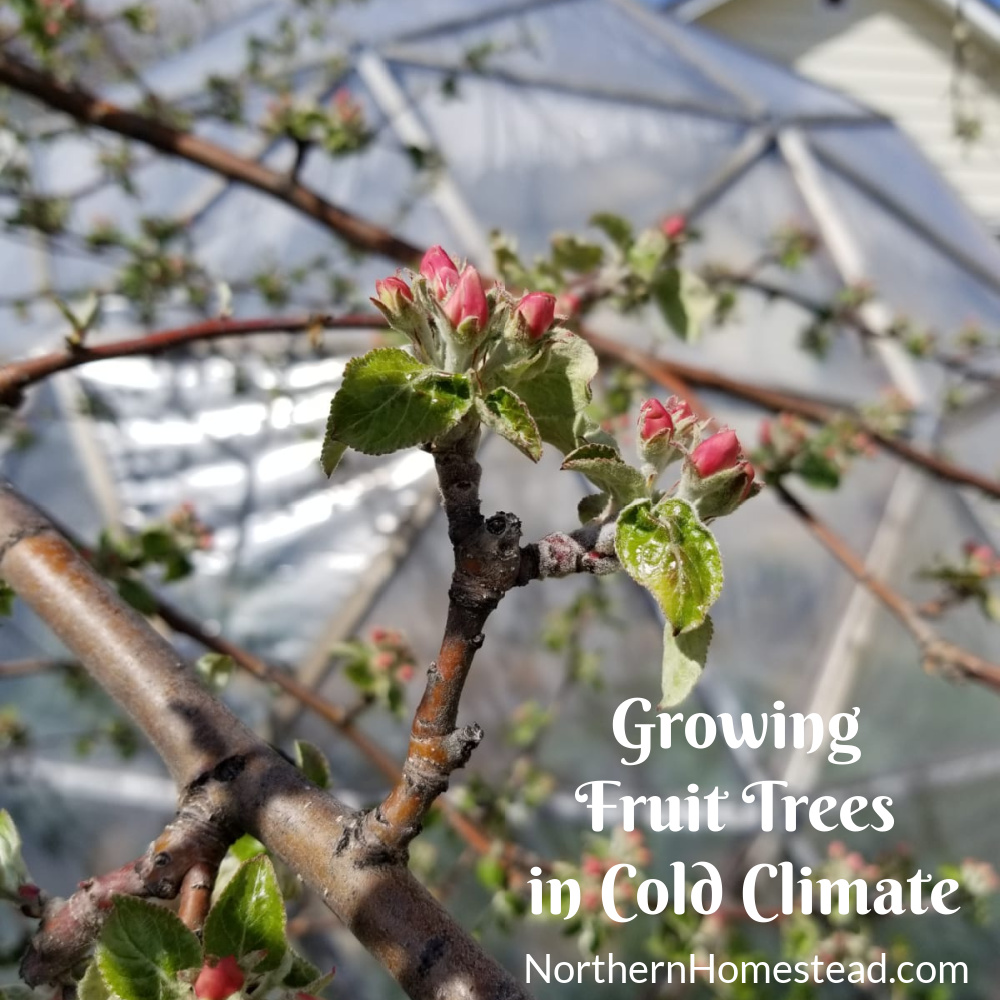
Growing fruit trees is one of our favorite things to do. We love fruit, and growing our own is the best way to have them. In fact, one of the reasons we wanted to have more space to grow was the desire to plant more fruit trees.
In growing fruit trees in a cold climate part 1, we cover what a cold-hardy fruit tree is, varieties, where to buy hardy fruit trees, pollination, and bare-root vs potted trees.
In part 2, we cover planting and caring for hardy fruit trees as we learn about them. As always, we would appreciate it if you shared your experiences with us in the comment section, so we all learn together.
Where to plant fruit trees
If we think of trees, a forest comes to mind. There are different stages in a natural forest. It starts with pioneer species, which will grow in almost any soil condition. Those are the native trees. The varieties will depend on the area and soil conditions. Aspen, maple, and poplars are common in our area. If a field is left alone, these trees will start to grow first. These trees like it sunny and do not mind wind and cold. If left alone, these trees will eventually be replaced by coniferous species.
Fruit trees are the more delicate trees in the tree family. If they are planted in an open field, instead of the native pioneer species, they will most likely struggle, and many will not make it.
To help with that, shelterbelts with hardy trees need to be planted first.
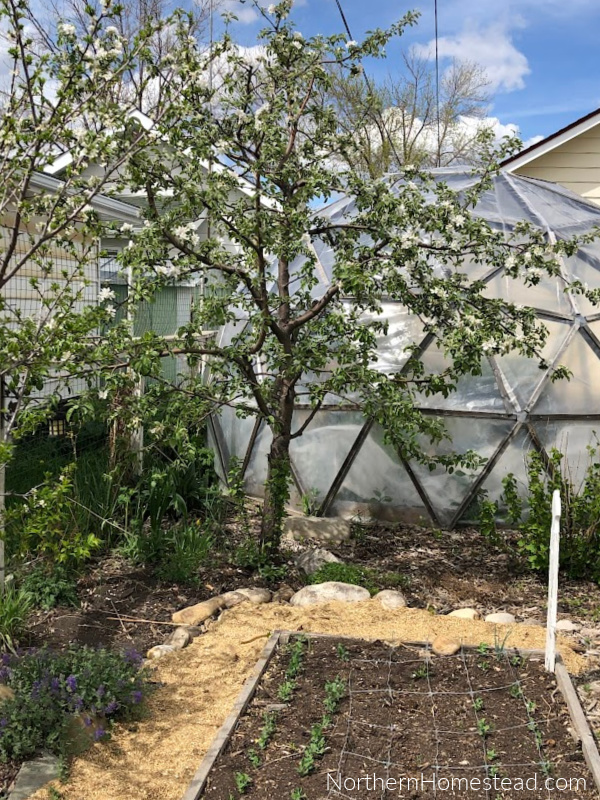
In an established site or urban setting, fruit trees can be planted anywhere where there is enough space for them to grow. Line the northwest border of your garden with fruit trees and berry shrubs to provide a microclimate for the more tender vegetable plants.
More sensitive varieties of fruit trees do better on the north side of a building, but still south of some shelter. This is because in that location, there is a higher likelihood of good snow cover. Snow is the best insulator in the winter and also keeps the soil frozen longer, preventing too early blooming.
Most fruit trees prefer a full sun location with at least 6 hours of direct sunlight.
How much room a fruit tree needs depends on the variety. Ideally, you know what the mature size of the tree will be and give it that much space. That being said, trees can be planted a lot closer. For pollination, and if there is no room for a second tree, you can even plant two young trees in one hole. As we observe in natural forests, trees often grow closely together.
Soil preparation for fruit trees
Trees need a fungal-dominant soil. Tilling and digging the soil brings the opposite of what fruit trees need. In other words, the best soil preparation for fruit trees is not to disturb the soil. At planting time, we only want to dig a hole for the tree itself.
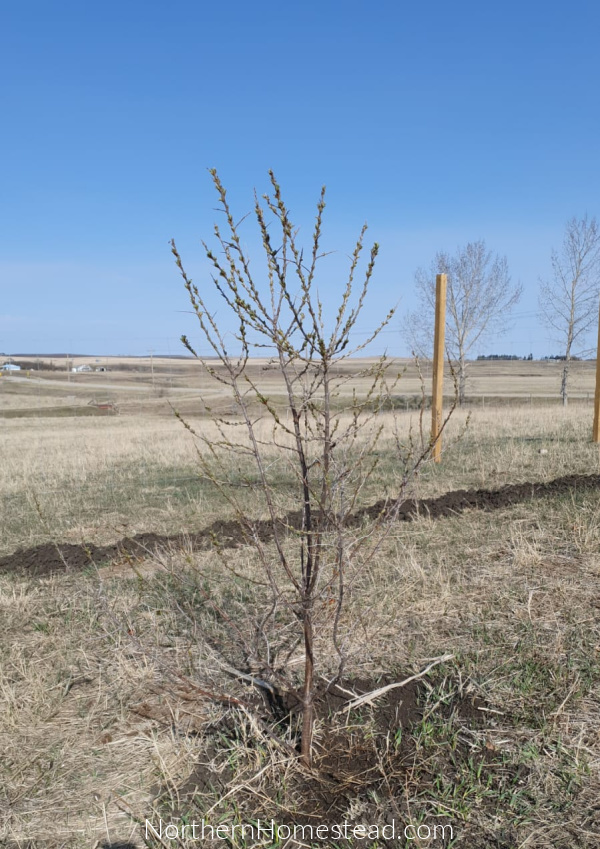
If you want to convert a field into an orchard, plant some hardy nitrogen-fixing species like sea buckthorn, locust trees, or russian olive first.
Very young fruit trees can be planted right with the first pioneers. More mature fruit trees are best planted in areas where other trees are already growing.
If that is not possible, and you just want one tree in the middle of your lawn, consider bringing in some fungi-dominant soil from under a mature fruit tree elsewhere. It will act as a starter for the fungi in your soil under your newly planted tree.
There are differing opinions on whether to allow grass or weeds to grow around the trees. Personally, I think it depends on the maturity of a tree. If a tree is very young, it is not much different than grass or weeds. The weeds or other orchard grasses protect the soil from evaporation during the day and gather moisture from dew during the night, which trickles down to the root system. Grasses also give a bit of protection from predators for a very young tree.
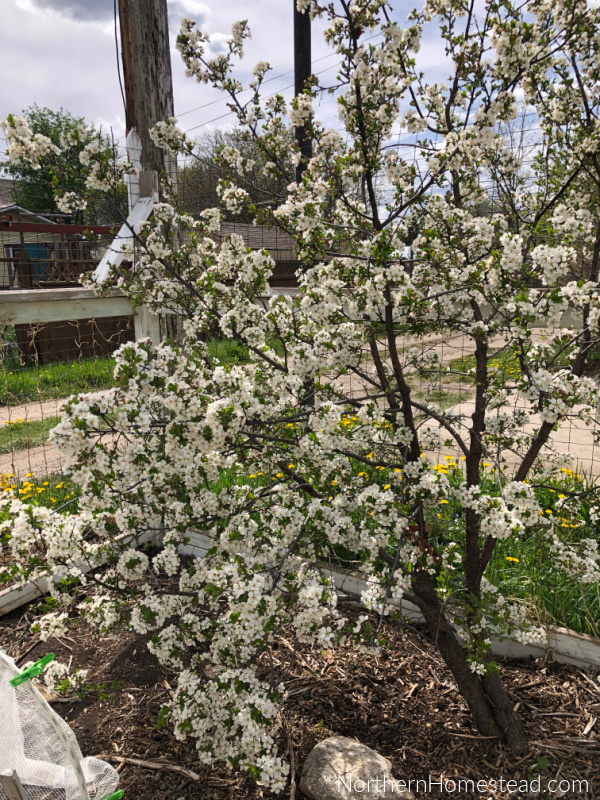
A more mature tree is best mulched with a thick layer of wood chips. It will mimic the forest floor, and help the tree to stay moist, and the fungi that the tree benefits from develop better.
Planting a fruit tree
Fruit trees are best planted when they are dormant. In our cold climate, spring seems to be the optimal time, although we have also achieved great results with fall planting. Only potted trees can be planted at any time, except do not plant in frozen soil.
Fruit trees are available as plugs (when very young), bare roots, or potted. Plugs are rare, as only fruit trees grown on their own roots are sold as plugs or one-year seedlings. Since most fruit trees in cold climates are grafted, you will more often find good fruit varieties as bare root or potted.
Personally, as we covered in part one, we prefer bare-root trees. Those are usually young trees that are surely not root-bound in a pot and have the best survival rate.
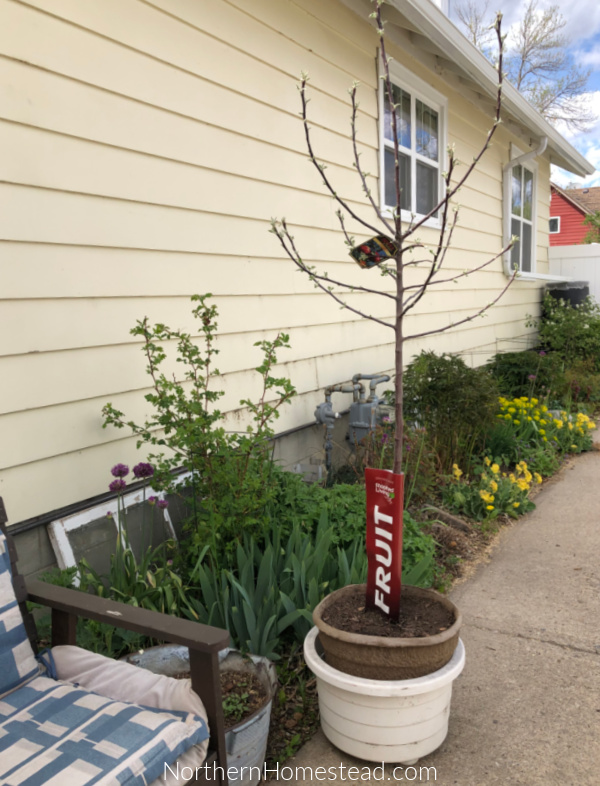
However, a high-quality potted tree has its value, especially if you want to harvest fruit sooner.
When buying potted trees, check if the roots are not crammed into a pot. If in doubt, loosen the soil and plant as a bare root. This can only be done, though, if the tree is dormant.
For all trees, you need a hole that is bigger than the plug, bare-root ball, or pot.
There is a saying that for a $5 tree, you need a $50 hole. Two things are very true for this statement. For one a smaller, read cheaper tree, is better than a more mature tree, and also the hole or planting is very important.
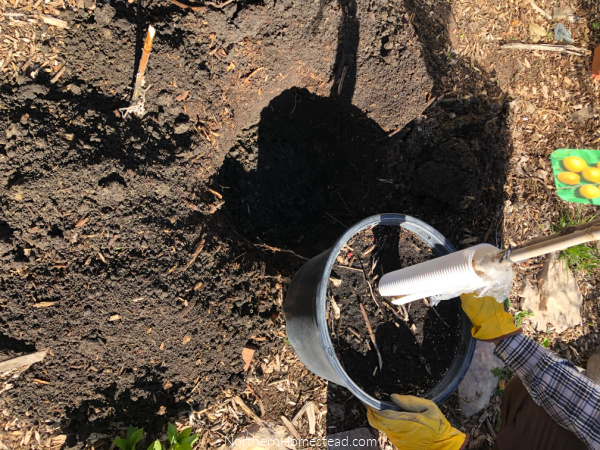
If you are planting a tree in good soil, full of organic matter, as is the case in our urban yard, no additional nutrients are needed. We like to improve the soil all around the tree with mulch and companion plants instead of giving the tree nice soil in a hole, and encouraging it to stay in that hole.
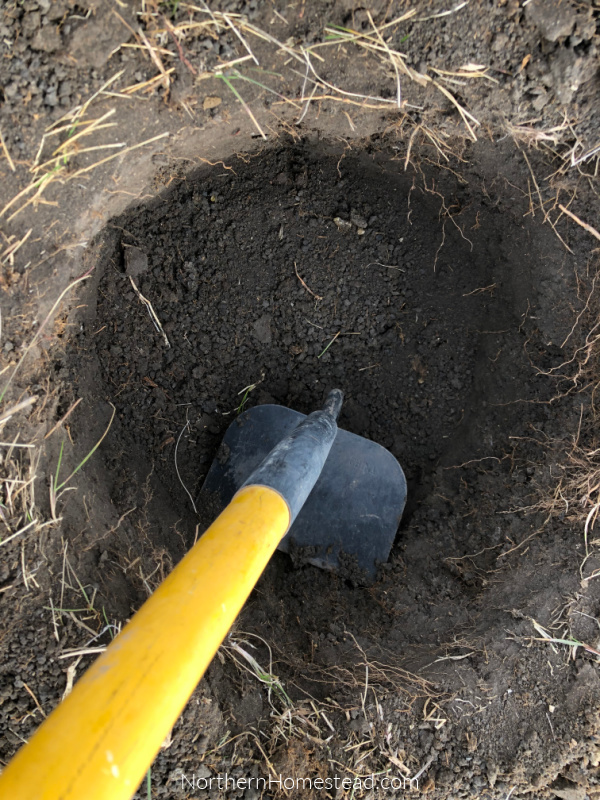
If you are planting a tree in very poor soil, a bigger hole is important. In this case, avoid a perfectly round hole by breaking up the sides, so that the hole becomes more star-shaped than round. Just like a round pot, a round hole in compacted soil has the same effect.
If your soil has poor drainage (check by pouring water into the planting hole and seeing if it drains away), you can layer some old wood into the bottom of the hole to give the roots better drainage. Another option is to plant the tree in a raised bed.
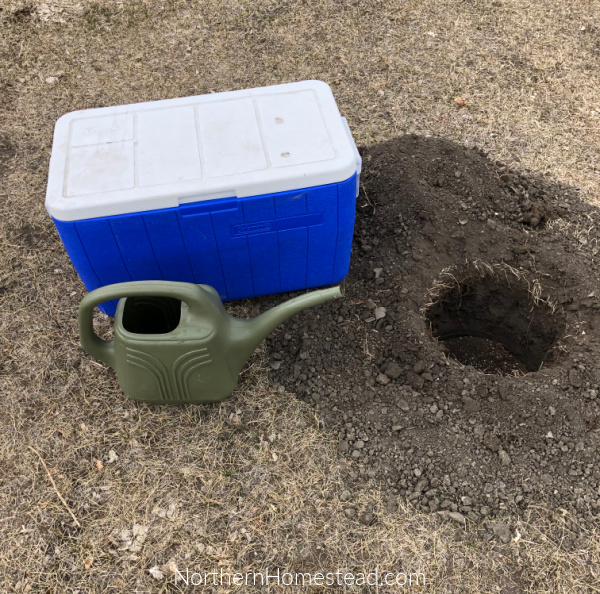
When planting bare-root trees, protect the roots from drying out. A cooler box is a great way to keep the tree out of sunlight and wind. Have the hole and water ready. If you can, choose an overcast day or plant in the evening.
Plant the tree and fill the hole with 2/3 existing soil and 1/3 peat moss, pine bark compost, or other humus soil conditioner.
Plant a potted tree at the same level as the tree was in the pot. A bare root tree just below the graft, where the root stops and the tree begins.
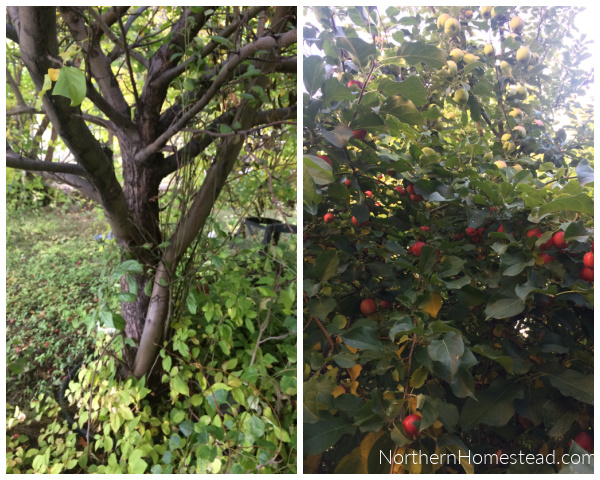
If a grafted tree is planted too deeply. If the graft is buried, there is a danger that the rootstock will also start to grow, resulting in a double tree (see picture above).
For bare roots, ensure that the roots are not j-d into a hole. You want them to look down or to the side, not up.
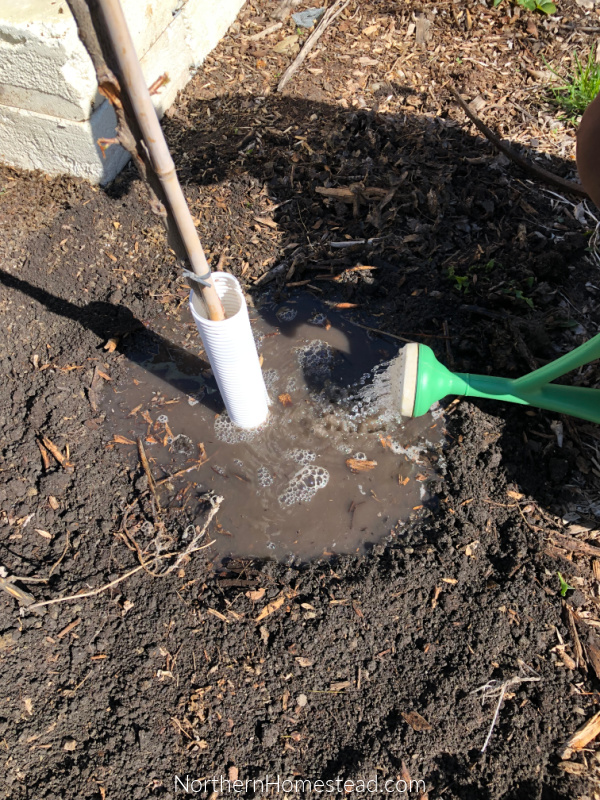
Fill in the soil firmly to eliminate any air pockets. Now build a water basin around the tree and water thoroughly.
Caring for a young fruit tree
The first year after planting is crucial for the tree’s growth. You want to give the tree the best start at your location for many years to come.
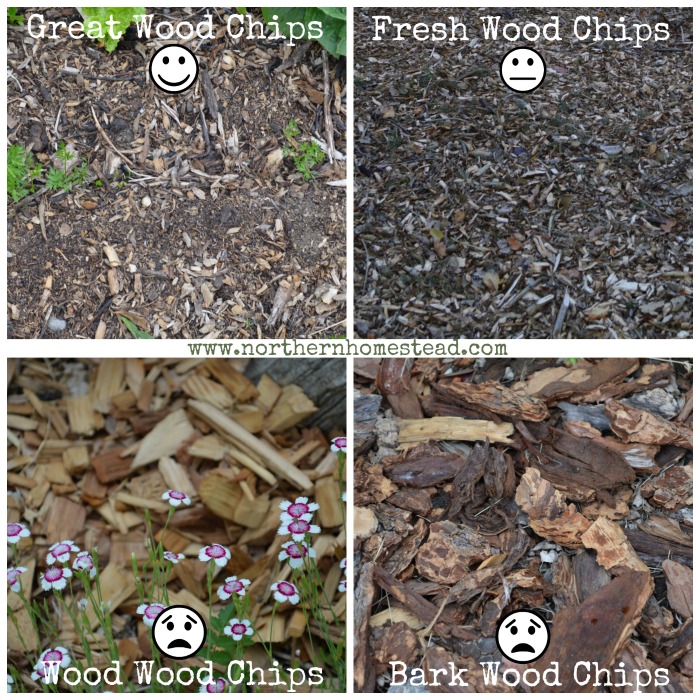
After planting and watering in, mulch the tree. We find the best mulch for trees is wood chips, chopped branches, and leaves. Not bark mulch or wooden wood chips, even though both are better than no mulch. Old branches and leaves would accumulate under a tree naturally if no one ever cleaned up. These are the woodchips that most tree companies or arborists have no use for. We often get it for free if we are only willing to load it ourselves.
Water the freshly planted tree once a week. The amount of water depends a bit on your soil and the size of the tree. You want the roots to be watered well each week.
Do not assume that rain is enough, unless it rains so much that the soil is saturated. Especially if the tree is bigger, the roots are still very small. The tree will require extra watering for up to three years.
Watering deeply is so important because you want the roots to grow deep. If you just let it rain, you might end up with a shallow root system, and the tree won’t be as stable as it should be.
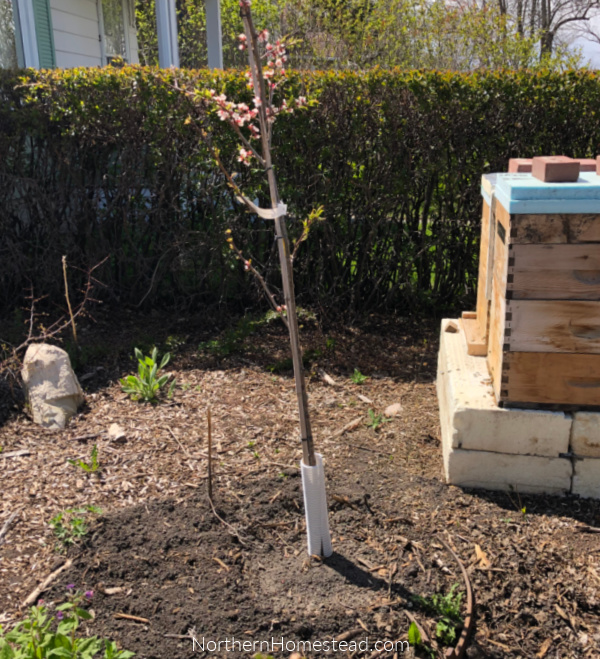
If needed, add protection from rodents at the base of the tree. The level of protection depends on the type of animal you are dealing with. Note that in the winter, snow covers some of the stem, so the protection must be higher if you have rodents coming through.
If the trunk of the tree is exposed to sunlight all day, it needs some protection. A white spiral tree guard can do both, protect from the sun and rodents.
In a windy area, a young tree needs staking. Use elastic or stretchy bands to hold the tree. It is better for the tree if it has some movement.
Companion planting for trees
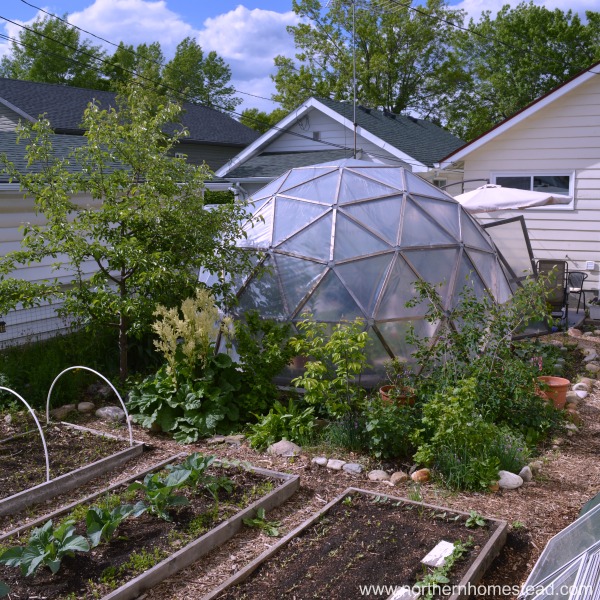
Fruit trees do not thrive when grown alone in the middle of a lawn or field. Plant chives, rhubarb, lilies, and other edible perennials around, and you get a beautiful plant guild. Adding some nitrogen-fixing plants, such as clover, comfrey, or lupine, will help the combination grow well.
In a cold climate, a permaculture food forest can be established by planting hardy berry bushes on either side of a fruit tree. In an orchard, it is better to interplant fruit trees with nitrogen-fixing trees. The Miracle Farm recommends two fruit trees to one nitrogen fixer in a row. It is not just beneficial for the soil and the growth of the trees, but the nitrogen-fixing tree in between also helps interrupt pests that might find their way into an orchard or food forest.
A tree or trees planted this way do not need a chemical fertilizer. We have never used any chemical fertilizers with great results. We only add a layer of wood chips, about every other year, and do not clean up leaves in the fall. However, we gather any fruit that falls to the ground to avoid any pests or diseases.
Pruning fruit trees
Fruit trees benefit from being pruned. Different varieties need different techniques.
Good timing is in the spring, just before the flowers open. It is a time when you are not in a way of pollinators, but you can already see where the fruit is forming, so as not to cut back fruit clusters.
Generally speaking, a tree is well pruned if it doesn’t notice it was pruned. For that reason, prune a tree a little each year. If in doubt, go to the professionals.
We are not professionals, so the information provided here is general in nature. We share simple things that we do to keep our trees productive.
A fruit tree can be pruned to be small or tall; however, this also depends on the rootstock.
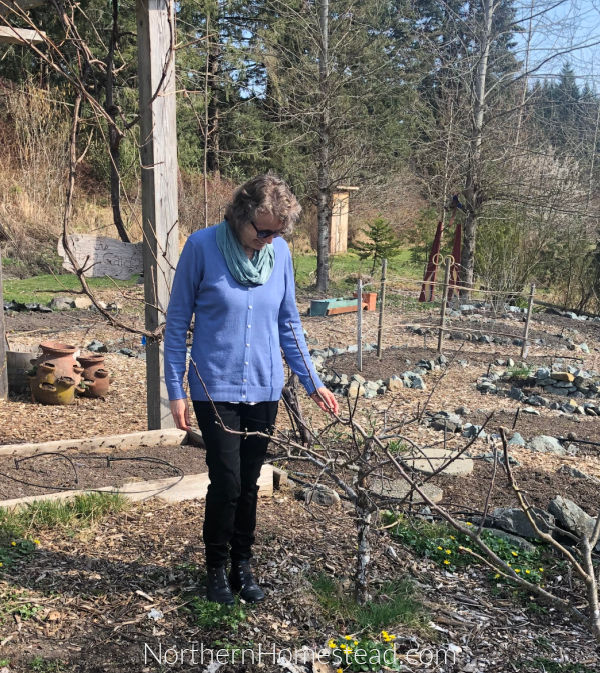
If we want to keep a tree small, it has to be on dwarf rootstock. A standard tree can be kept fairly small by encouraging low growth, cutting back what grows upward, and maintaining what grows downward. Trimming upper branches to half only encourages more upper growth, so refrain from doing that.
Suckers, twigs that grow straight up, eventually have to go. However, they can be very productive in the first year.
We also prune branches that grow in and across, to keep the middle more open. The goal of pruning is always to give each branch the much-needed sunlight to ripen fruit.
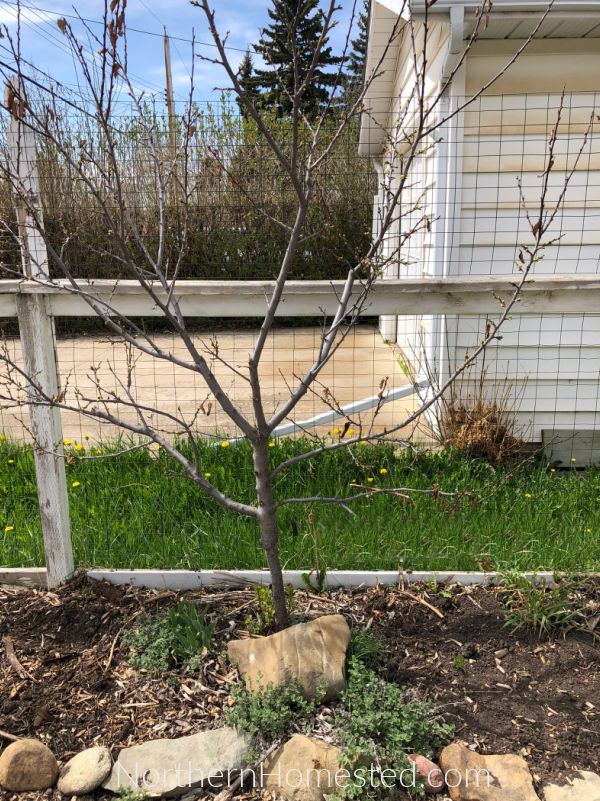
Most of the trees in our urban property are planted along the border. We prune them to stay slim. Since the location is very sheltered, this is mostly possible without even having support.
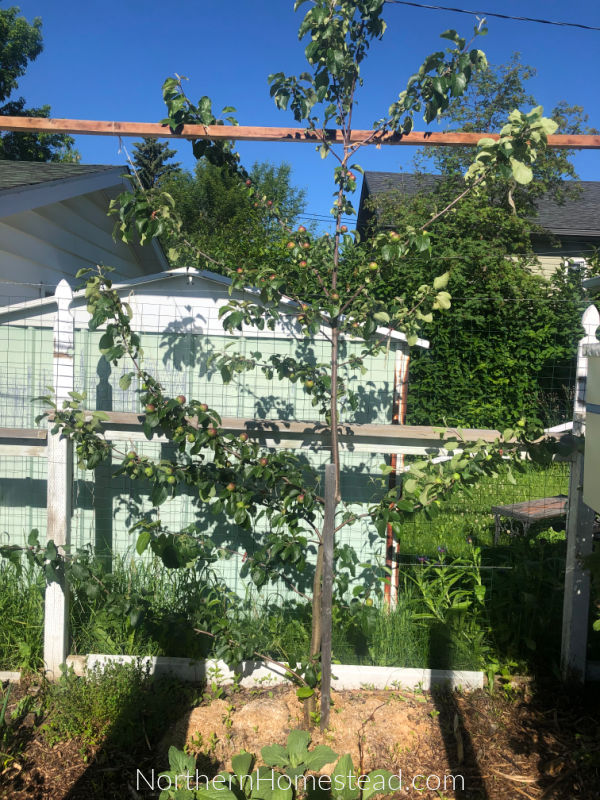
However, a fast-growing tree, such as our M360 apple tree, does require support. In this case, it would probably have been better to create a real espalier tree.
Winter care for fruit trees
A cold climate can be harsh on fruit trees. Right before the ground freezes, we water our fruit trees to make sure that when the spring melt comes, they have moisture to start growing.
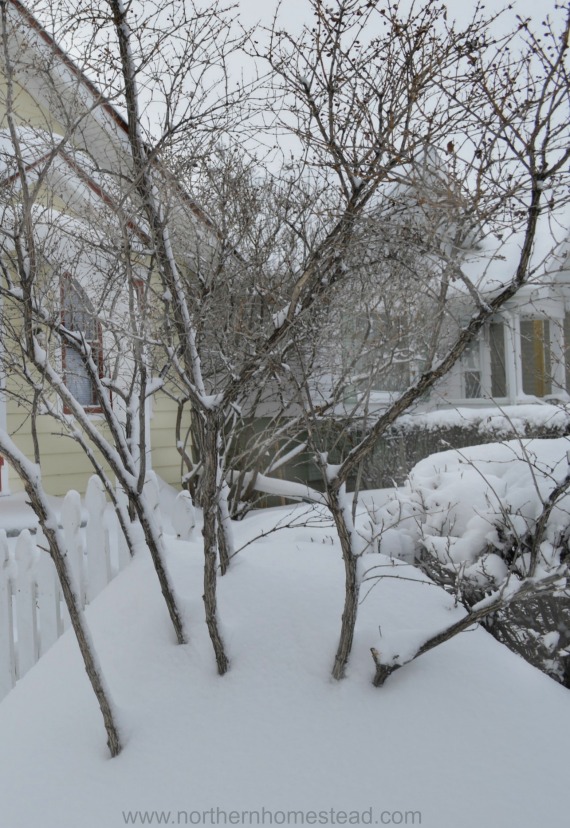
For more tender trees, we make sure they have a good snow cover. If that is not possible, adding extra mulch in the fall helps too.
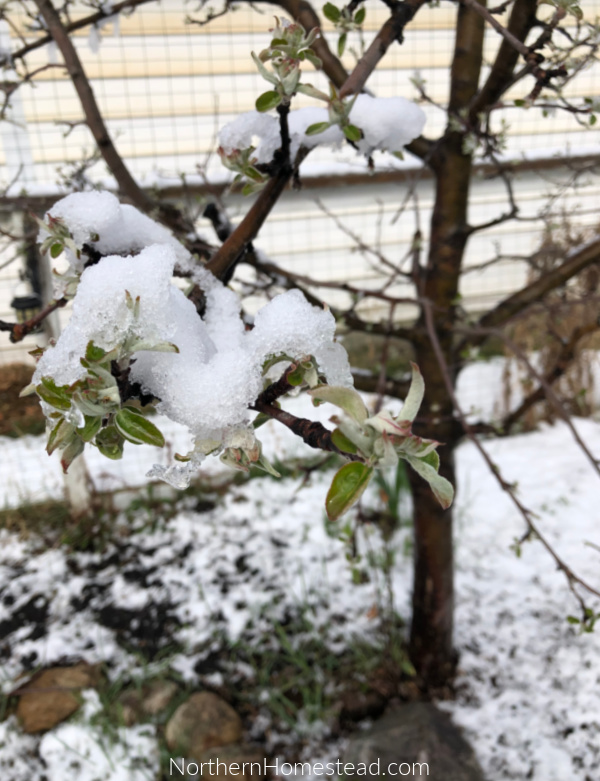
In our climate, it can snow at any time of the year. If the tree already has leaves, shake the snow off as soon as possible. Wet snow on leafed trees can be very heavy and may cause damage by breaking branches.
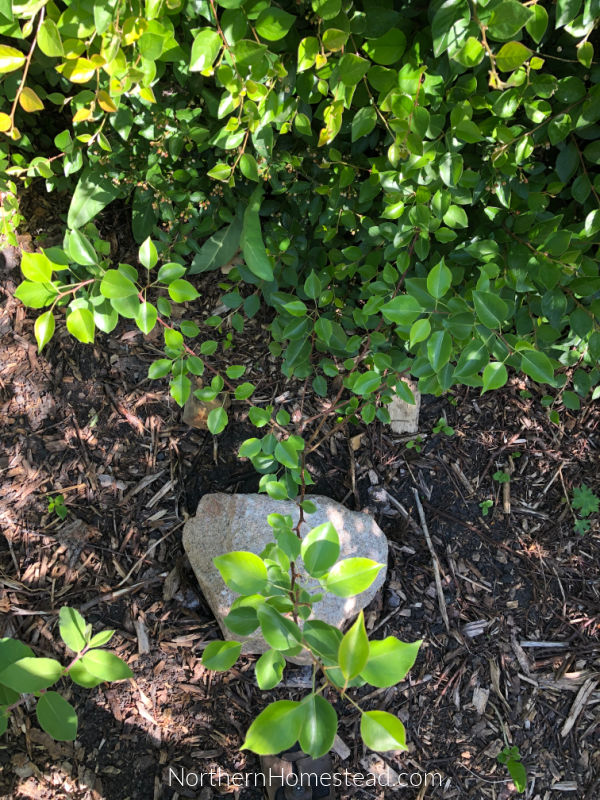
We like to place a large rock near the stem under each fruit tree. The rock helps maintain a more consistent temperature. In the winter, it stays frozen under the rock longer. In the summer, the rock releases some of its heat. Is this proven science? Not to our knowledge, it’s just our practice.
What is a practice that has worked well for you while growing fruit trees in a cold climate? Please share in a comment below.
We invite you to subscribe to Northern Homestead and follow us on Instagram, Facebook, or Pinterest for the latest updates.
More Trees and Shrub Articles You Might Enjoy:
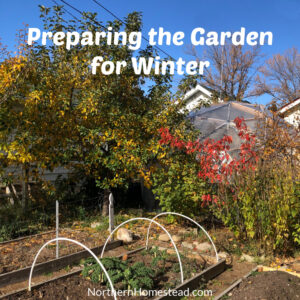
Preparing the Garden for Winter in a Cold Climate
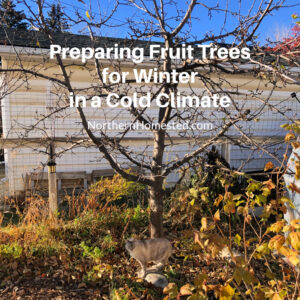
Preparing Fruit Trees for Winter in a Cold Climate
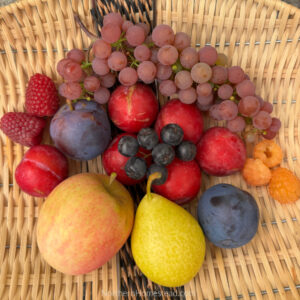
Picking Fruit and Berries at Their Peak
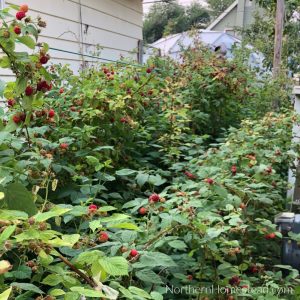
A Complete Guide to Growing Hardy Raspberries in Cold Climates
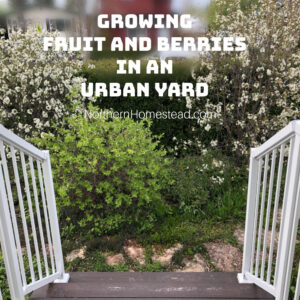
Growing Fruit and Berries in an Urban Yard
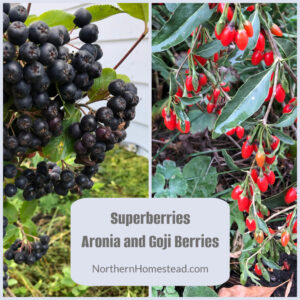
Growing Aronia and Goji Berries in an Urban Garden
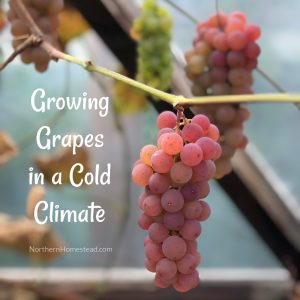
Growing Grapes in a Cold Climate
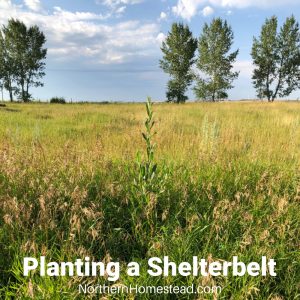
Planting a Shelterbelt
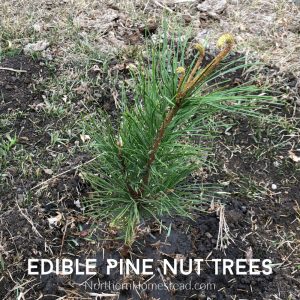
Growing Edible Pine Nut Trees
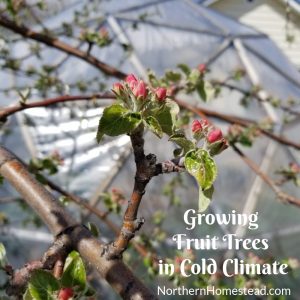


Helpful article, thank-you! I especially like where you say “don’t do that” to reducing upward-facing branches by half. That is something I am finally understanding! I also appreciated the confirmation that pruning to downward-facing buds in fruit trees IS done to keep branches accessible. I probably have been reading that for years, but this year it stuck! Now I am wondering about the big rock at the base of the fruit trees. Which direction do you place this on? South? West? North?
Thank-you.
Glad to hear the information is helpful. We place the rock so the sun can warm it up. I can’t prove though that the rock makes any difference. It really is just a habit.